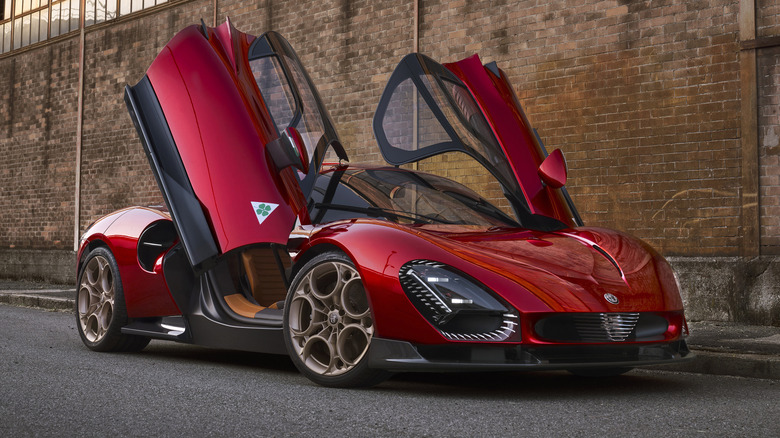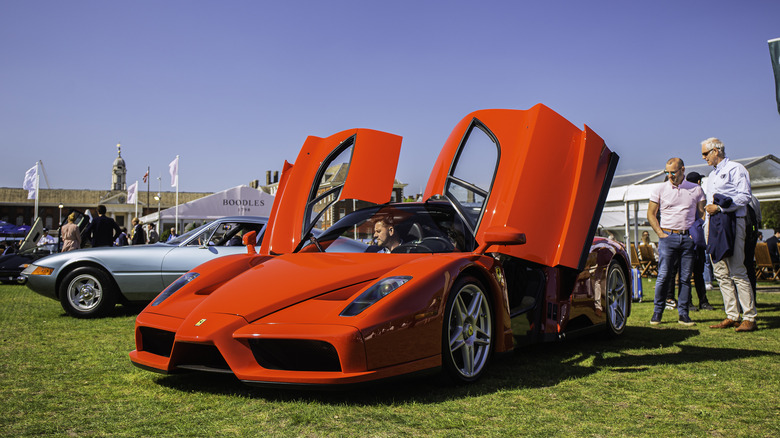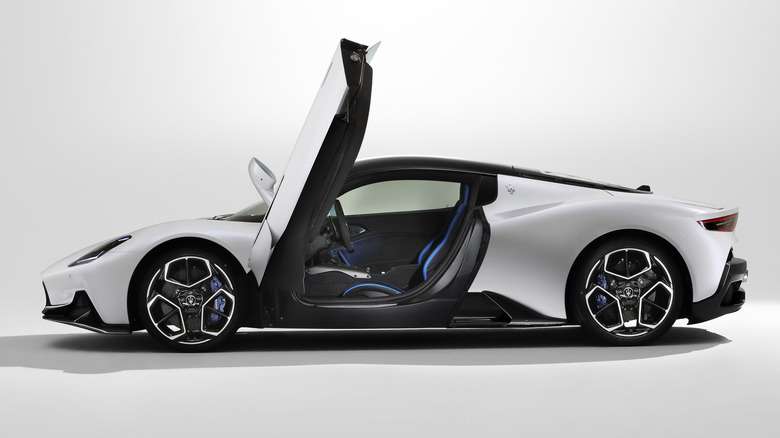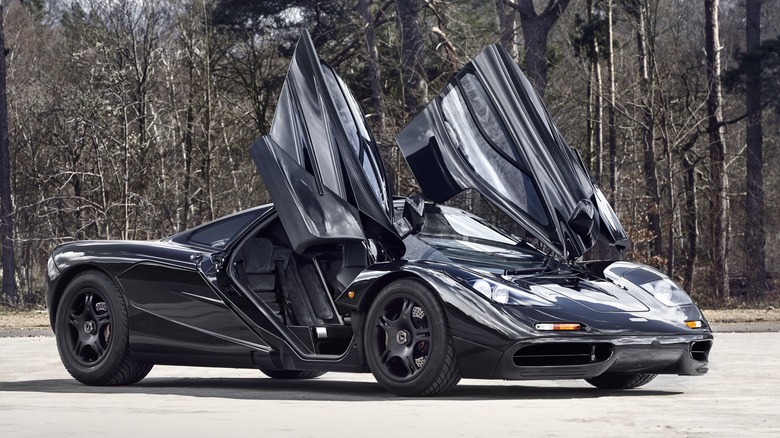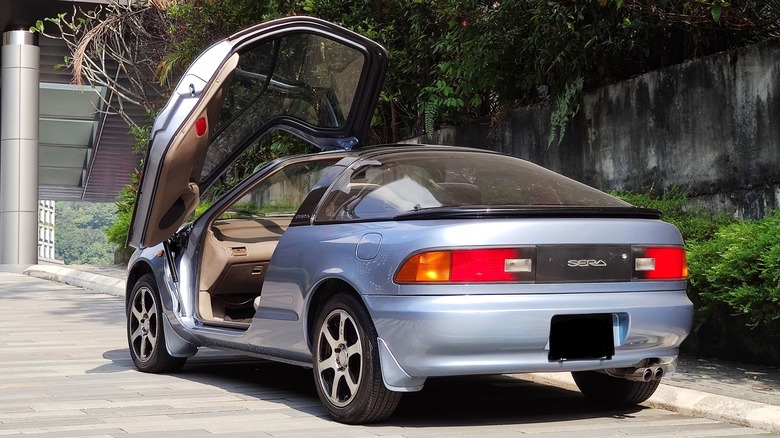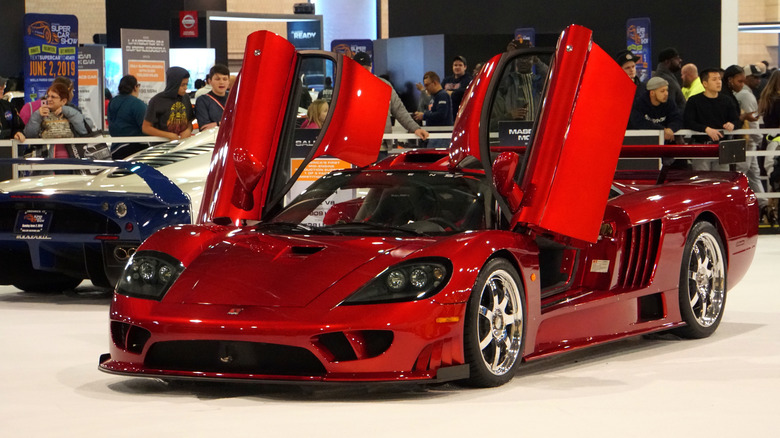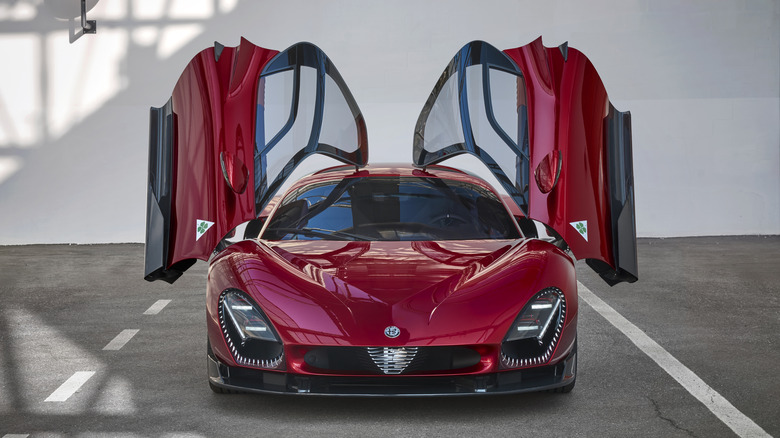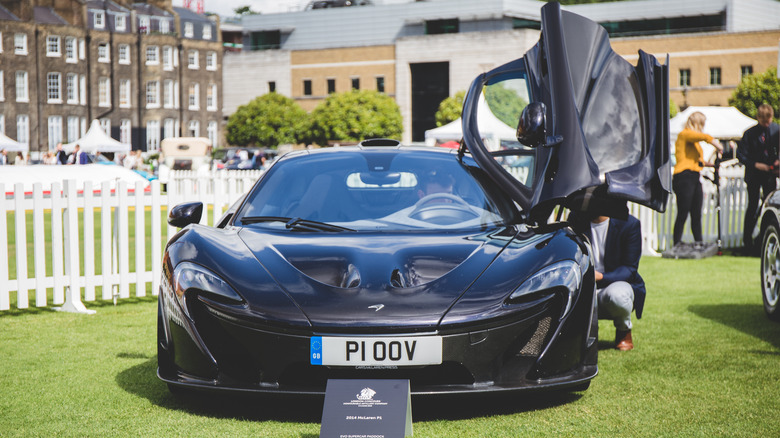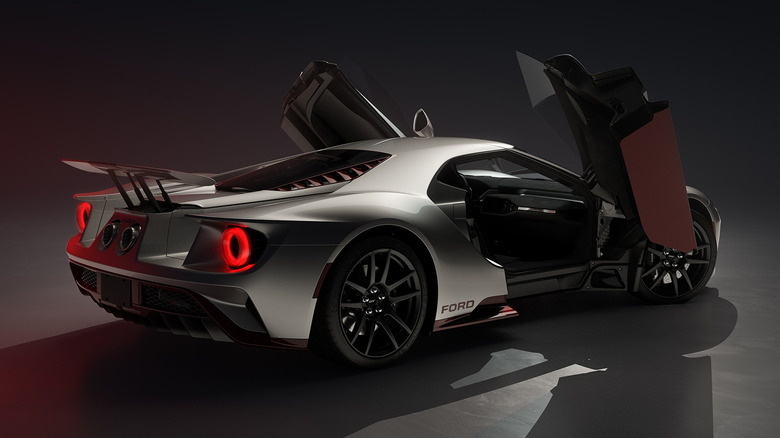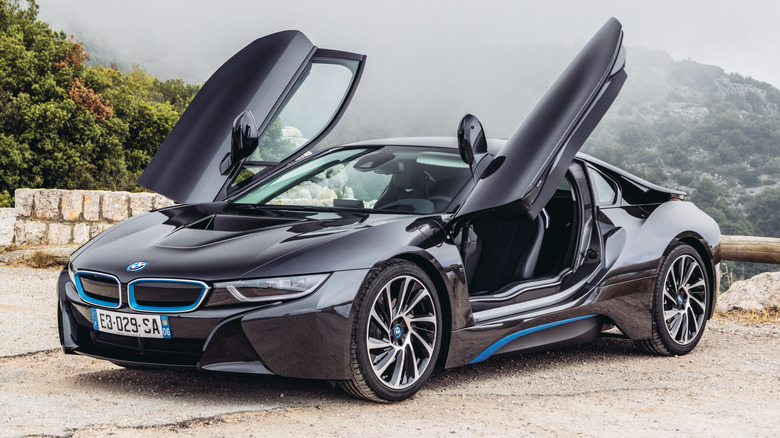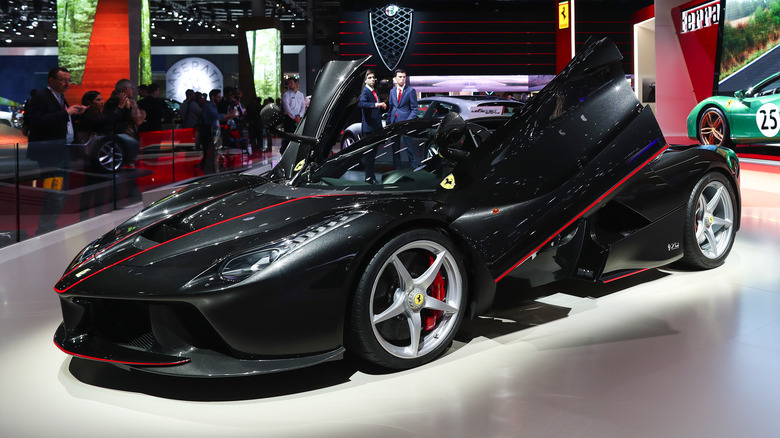10 Of The Coolest Cars With Butterfly Doors
Butterfly doors are one of the most visually striking types of car doors, and also among the most unusual. By definition, these doors open in the same manner as a butterfly's wings — that is, upwards and outwards simultaneously. They're different from scissor doors, which open directly upwards, although both are attached at the car's A-pillar, behind the front wheel.
While their added complexity means that they're most often reserved for exclusive, high-end cars, there are some key benefits to using scissor doors over conventionally opening doors. They're often used to improve driver and passenger access to the cabin, especially in supercars that might have wide sills or wheel arches that would otherwise obstruct entry and egress. Aside from that, however, they also just look cool and add an extra layer of drama to the design of a supercar.
Below are among the coolest cars to use butterfly doors, ranging from $20 million hypercars to sub-$20,000 JDM oddities. Despite first appearing on a production car in the '60s, they've remained remarkably rare ever since, which makes any car that does feature them automatically a head-turner. Although, it's safe to say that most of these cars would have already drawn a crowd even without their unique doors.
Ferrari Enzo
The Enzo marks a turning point in Ferrari's history, as it's generally considered the last great analog Ferrari before the introduction of advanced electrical systems fundamentally changed how the brand's halo cars were designed. Nonetheless, it was a very advanced car for its time, both in terms of raw performance and in terms of technology. Many of its innovations were derived from the marque's Formula 1 program, with Ferrari racing ace Michael Schumacher playing a key role in the Enzo's development.
Schumacher's job was primarily to ensure the car handled like a Ferrari halo car should do, while Ken Okuyama, a Japanese designer then working for Pininfarina, was in charge of crafting the car's distinctive silhouette. Okuyama's design was unconventional in many ways, with one such difference being the car's butterfly doors. All of the Enzo's predecessors — those being the F50, F40, and 288 GTO — had featured conventionally opening doors, making the Enzo an outlier.
The car's unique shape was designed to produce maximum downforce at high speeds, negating the need for a rear wing which its predecessors relied on to keep the rear tires firmly stuck to the asphalt. However, the compromise was that the wide rear arches would have obstructed the driver's access if conventional doors were used, and so the butterfly design was a necessity.
Maserati MC20
While the Ferrari Enzo used butterfly doors primarily to accommodate its cutting-edge aerodynamics, the Maserati MC20's designers recognized the visual impact such doors can have too. The brand says that, while the doors help make access to the cabin easier, they also serve as a way to "set the scene," providing an extra visual spectacle when entering and exiting the car.
The MC20 is Maserati's current halo car and the spiritual successor to the Ferrari Enzo-based MC12. Despite the Enzo featuring butterfly doors, the MC12 used conventionally opening doors, making the MC20 the first Maserati to feature the butterfly door design. It's groundbreaking in other ways too: during our time with the MC20, we noted that the car felt significantly different to the previous Maseratis inside. The cabin materials and technology were a step above the brand's other models, with everything from the leather and Alcantara upholstery to the model-specific infotainment system feeling like an upgrade.
The door design also meant that getting in and out of the cabin was not as challenging as many other supercars. Combine that with the novice-friendly handling and comfortable ride (at least by supercar standards), and the result is a car that could feasibly be used as a daily driver. That is, as long as you've got pockets deep enough to deal with the near quarter-million dollar starting price.
McLaren F1
The McLaren F1 remains one of the fastest road cars ever made, and when it was first unveiled, it rewrote the rulebook on what a performance car could achieve. Nothing before it had managed to combine record-breaking speed and razor-sharp handling, never mind still qualify for a license plate. Its designer Gordon Murray took inspiration from a wide variety of cars when penning the F1, with the inspiration for its butterfly doors coming from a small, obscure Japanese sports coupe.
Its handling was benchmarked on another Japanese car, the Acura NSX, while its power was sourced from a racing-derived BMW V12. The aerodynamics and materials used for the car were derived partly from McLaren's Formula 1 expertise, with this globe-spanning combination of ideas and technical know-how eventually producing a car with truly world-beating performance.
Its pedigree has helped its value rise considerably over the years, with the rarest examples selling for more than $20 million. That makes it one of the most valuable cars ever to feature butterfly doors, as well as one of the fastest.
Toyota Sera
Ironically, while the McLaren F1 is about the most expensive way to buy a car with butterfly doors, the car that inspired its design is among the very cheapest. That car is the Toyota Sera, which featured a modest 1.5L four-cylinder engine making 108 horsepower. Gordon Murray reportedly found out about it while working on the initial design for the McLaren F1, and brought one into his workshop so he could figure out how the door design worked.
However, there's more to the Sera than simply being a design inspiration for one of the greatest performance cars ever made. The Toyota also featured several futuristic tech systems including a Super Live Surround Sound stereo system. It was designed to mimic the feeling of listening to a live performance and bounced soundwaves off the car's curved windows to help generate the surround sound effect.
Both the doors and the stereo system were designed to appeal to young buyers in Toyota's home market, and as such, the car was never officially sold outside Japan. However, its unique design has meant that several examples have been exported over the years, with a few finding their way to American shores.
[Featured image by Pycy via Wikimedia Commons | Cropped and scaled | CC BY-SA 4.0]
Saleen S7
It's not just European exotics or quirky JDM cars that have used butterfly doors over the years. American manufacturers have used them on occasion too, with one of the earliest manufacturers to do so being Saleen. The S7 was the outfit's first supercar, but founder Steve Saleen's name was already well known in tuning circles thanks to his work modifying Ford Mustangs. The S7 was a joint British-American project, with Saleen designing the car but the Ray Mallock race team handled a significant part of its development.
The car's Euro-rivaling looks, including its butterfly doors, belied a comparatively simplistic powertrain. Power was sourced from a Ford V8, which initially produced 550 horsepower but was later upgraded to produce as much as 1,000 horsepower thanks to beefy twin turbochargers. Production began in 2000 and ran until 2009, but production numbers have never been officially released.
The eye-catching doors were, like many other aerodynamically-minded supercars, there for practicality reasons as much as for show. The car's sills were wide and conventional doors would have made it very difficult to get in and out of the cabin. However, with the butterfly doors fitted, the S7 was no more tricky to clamber into than any other supercar.
Alfa Romeo 33 Stradale
The reborn Alfa Romeo 33 Stradale takes heavy styling inspiration from its '60s predecessor, becoming the brand's first halo car since the 8C Competizione. Its low-slung lines already make it stand out from its peers, but adding to the drama is a pair of butterfly doors. The original 33 Stradale, produced between 1967 and 1969, was the first production car to feature such doors. In that short production run, only 18 examples were built, but 33 examples of the latest car will be built.
Buyers have a choice between either a 620 horsepower twin-turbo V6 engine or a 750 horsepower all-electric setup. Both variants hit 62 mph from a standstill in less than three seconds, although the gas car boasts a higher top speed, reaching 206 mph. The BEV tops out at 192 mph.
The car was announced to the public in August 2023 but had already sold out a year prior. Each example can be customized to the buyer's preferences via a small group of specialist designers, so it's safe to assume that no two examples will be the same. Pricing wasn't announced, but given the car's looks, power, and exclusivity, any examples that do make it to public auction will likely command a significant premium over their original asking price.
McLaren P1
Producing a follow-up to the iconic McLaren F1 was always going to be a difficult task, but the P1 has largely managed to carve its own legacy as a groundbreaker rather than remain in the shadow of its predecessor. A limited run of 375 examples were produced, each one equipped with a hybrid gas-electric powertrain making a combined 903 horsepower. Top speed was limited to 217 mph, reportedly to preserve the life of the car's hybrid system.
Although McLaren was always keen to emphasize that the P1 was more than an F1 successor, the newer car did copy plenty of the F1's design quirks. Among them was the distinctive set of butterfly doors, which like the '90s supercar, helped facilitate easy access to the cabin. Once inside, drivers were faced with a stripped-back cabin with a forensic focus on weight saving – even the carpets were designed to be lightweight.
Several special edition P1s have been produced in the years since the original production run ended, all of which feature the same distinctive doors as the original car. The P1's unique design, along with its cutting-edge performance, has ensured that owners looking to resell the car have made a healthy profit over its original £866,000 (around $1.36 million at the time) list price.
Ford GT
The Ford GT of the 2000s is a great example of why door design is more important than it might initially seem. Despite boasting the looks and performance to keep up with the greatest supercars of its era, it suffered from a few practicality flaws. One such flaw was the strange door design: they opened conventionally, but included part of the roof, making getting in and out of the car a very awkward endeavor. For the latest GT generation, Ford decided to fix the problem by fitting a set of butterfly doors instead.
The design of the new GT, which SlashGeardrove at launch in 2017, was heavily influenced by racing. All road cars feature an FIA-compliant roll cage, just so that the race version of the car could be slightly lighter than its rivals. The mid-mounted V6 engine also produces a soundtrack worthy of an FIA GT racer, meaning that anyone lucky enough to spot one of the 1,000 examples on the road will hear it coming long before they see it.
BMW i8
While butterfly doors are generally intended to make cabin entry and exit easier, some cars implement the idea better than others. We weren't convinced about the practicality of the BMW i8's butterfly doors during our time with the car, but it's easy to forgive that considering its head-turning looks. The fact that the car still looks cutting-edge, despite the production version debuting a full decade ago, is a testament to its pioneering design. However, its performance is just as controversial today as it was back then.
Despite its spaceship styling, the i8's three-cylinder engine and single electric motor only make a combined 362 horsepower. The sprint from 0-62 mph takes a relatively unremarkable 4.4 seconds, in part thanks to the added weight of the batteries and electric motor. However, those batteries are only able to power the car for up to 22 miles of all-electric range.
While it's easy to speculate about what the car might have been like were it fitted with a more powerful gas motor, the reality is that the horsepower on offer was more than enough for most drivers. More than 20,000 examples of the car were sold before production ended in 2020, and no direct successor has emerged in the years since. Its segment-defying combination of supercar styling and GT performance might not be for everyone, but it's undoubtedly one of the Bavarian brand's most memorable cars of the century. That's enough to safely earn a spot on this list.
Ferrari LaFerrari Aperta
When Ferrari's engineers were developing the convertible version of the LaFerrari, they hit several stumbling blocks. The biggest issue was how to preserve the car's rigidity — a problem solved by making a series of major chassis modifications — but there was also the issue of how to accommodate the car's doors. The attachment points for the butterfly doors on the original LaFerrari had to be removed to create the roofless version, and so the whole mechanism subsequently had to be modified.
New attachment points for the doors were designed, although this meant the doors then opened at a different angle and caught against the wheel arches. Thus, the wheel arches also had to be reshaped, making the car's entire side profile slightly different from that of the hardtop car.
The tweaks allowed the LaFerrari Aperta to retain the dramatic door design of the original car, as well as make it as easy as possible to get in and out of. It's something that high-profile Aperta owners like Gordon Ramsay and Lewis Hamilton are sure to appreciate, especially considering few other cars on the road will attract quite so much attention.
